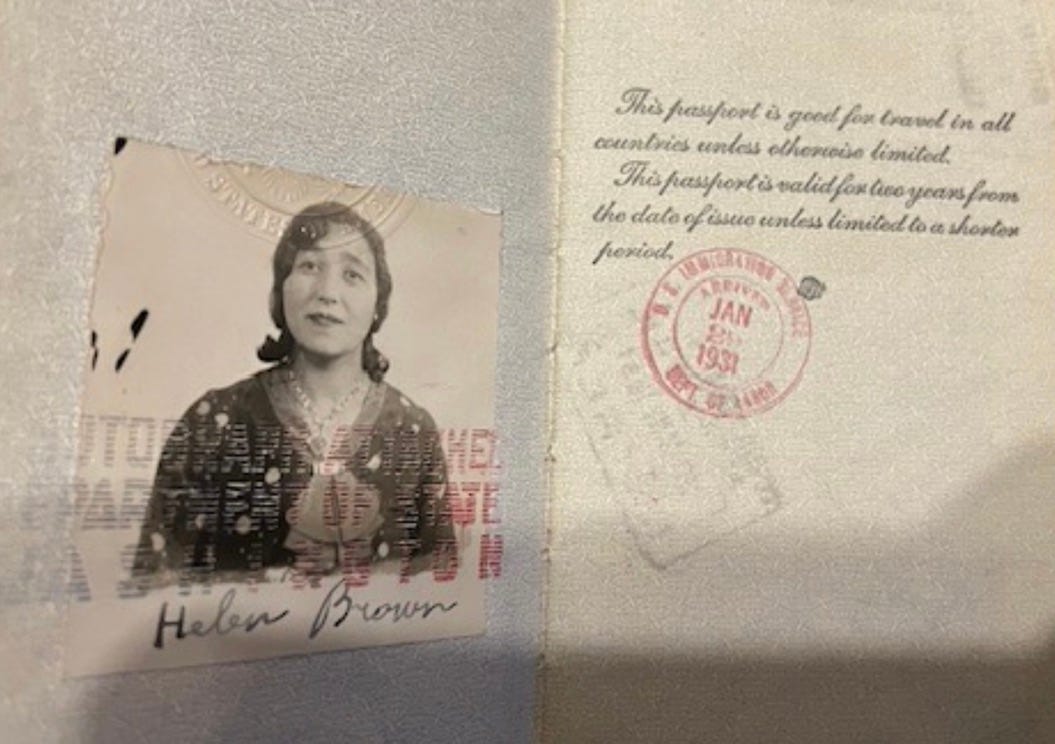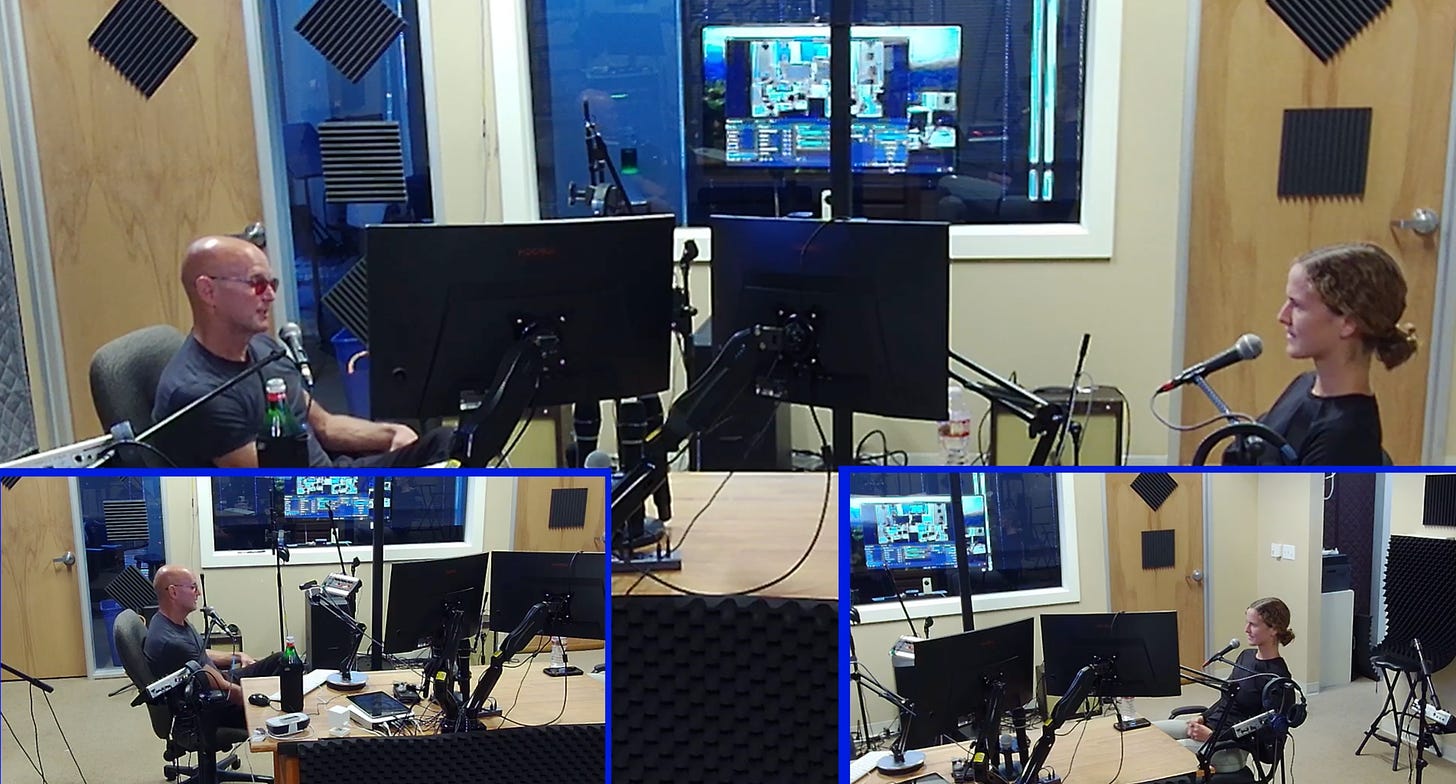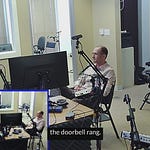“OG” Great-Grandma Helen
Deep Dive Summary
In the “teaser” segment, Steve tells daughter Hannah of her “Original Gangsta” (OG) Great-Grandmother Helen, who at age 16 traveled by herself from Hungary to the US by boat through Ellis Island (circa 1919-20) to become a US citizen. After the podcast recording, Steve confirmed with his father that Helen spent several years working as a seamstress living with her older sister Margaret Roth in New York. Helen returned by boat to Hungary to bring back (again by boat!) future Great-Grandfather Irving. Pictured above is Helen’s passport stamped in 1931, likely around the time she went back to Hungary for Irving. Steve also confirmed after podcast recording that Helen additionally brought back her younger sister’s son Stanley who was orphaned when her sister died after childbirth. Helen and Irving adopted Stanley, and had two children in the US - Gladys and Jim (Steve’s father - Hannah’s grandfather).
Introducing Hannah:
Steve introduces his other daughter, Hannah Muskal, who is 24 years old and has spent most of her life in school, earning multiple degrees and certifications (e.g. EMT and CNA), including associate degrees in French and psychology from MiraCosta Community College, which she attended during high school. She initially took a Spanish class there and enjoyed it so much that she continued with more languages and other subjects like economics and sociology. Hannah shares her experience of being treated like an adult while taking college classes in high school and recommends this path for other students.
Hannah later completed her undergraduate degree in psychology at Cal State San Marcos, where she also took pre-med courses. Encouraged by a coworker at MiraCosta, she applied to Semmelweis University in Budapest for medical school at the last minute and was accepted. The program is six years long, with the first three years focused on theoretical studies and the next three on clinical practice. Hannah shares that she has completed two years and is about to start her third. Steve and Hannah also talk about the challenges and benefits of studying medicine in a foreign country, including the need to learn a new language for clinical practice.
The conversation shifts to Hannah’s research on astrocytes in schizophrenia, highlighting the lack of extensive studies in this area. They also talk about the importance of considering the gut-brain connection in research.
Steve and Hannah delve into the topic of astrocytes, also known as astroglia, and their role in brain function and disease. Astrocytes are a type of glial cell in the central nervous system that perform various crucial functions, such as maintaining the blood-brain barrier, regulating blood flow, and supporting metabolic processes in the brain.
Functions of Astrocytes/Astroglia
Blood-Brain Barrier: Astrocytes are integral to the formation and maintenance of the blood-brain barrier, which protects the brain from harmful substances while allowing essential nutrients to pass through.
Metabolic Support: They play a vital role in glucose metabolism, converting glucose to lactate, which neurons then use for energy.
Neurotransmitter Regulation: Astrocytes regulate the levels of neurotransmitters like glutamate, ensuring that excess glutamate does not accumulate, which could lead to excitotoxicity and neuronal damage.
Plasticity and Repair: These cells are involved in the repair and scarring process of the brain and spinal cord following traumatic injuries.
Astrocytes in Disease
Hannah discusses her research on astrocytes in the context of schizophrenia. Key points include:
Pathological Changes: In conditions like schizophrenia, astrocytes may exhibit morphological changes, such as alterations in size or density. Her research aims to determine whether these cells are larger or smaller in patients with schizophrenia and to assess their density.
Neurodegeneration: In late-stage schizophrenia, there is typically a reduction in the number of astrocytes due to neurodegeneration.
Acute Inflammation: In acute inflammatory conditions, astrocytes tend to aggregate or clump together, which is another area of focus in her research.
Research Gaps and Challenges
Hannah points out that there is limited research specifically on astrocytes in certain brain regions in schizophrenia. While there are a few studies on astrocytes in the context of diseases like Huntington's, there is a significant gap in understanding their role in schizophrenia.
Potential Research Directions
Steve brings up the idea that understanding astrocytes in the brain should be part of a more holistic approach to studying diseases. He suggests that researchers should also look at other organ systems, such as the gut, to understand the potential systemic nature of disorders like schizophrenia. This includes exploring the gut-brain axis and its impact on neurological health.
Hannah mentions that while her lab is currently focused on the brain, it might be beneficial to consider studying astrocytes in relation to other bodily systems. This holistic view aligns with the growing interest in how gut health, for example, can influence neurological conditions.
More on Semmelweis:
Hannah was accepted to Semmelweis University about a month after applying, which is significantly faster compared to the typical one-and-a-half to two-year process for most medical schools. The medical program at Semmelweis is standardized, allowing graduates to work anywhere by passing the relevant licensing exams and learning the local language.
Ignaz Semmelweis, after whom the university is named, was a Hungarian gynecologist who discovered that hand washing with chlorinated solutions drastically reduced childbed fever deaths. Initially ridiculed and deemed insane, his methods were only recognized posthumously. This story exemplifies how medical advancements often take years to be accepted, as doctors can be slow to adopt new research.
A brief aside: Steve shows pictures of Hannah from her childhood, highlighting her involvement in community activities like trick-or-treating events and art camps. Steve jokingly was expecting Hannah to be more artsy given her early childhood activities.
The discussion turned to wellness centered on Hannah's experience with nutrition and physical fitness during her medical studies. She noted that while her school briefly covered nutrition in biochemistry, it wasn't a significant part of the curriculum. She highlighted the poor quality of food in the school cafeteria, which offered mostly unhealthy options like mushy vegetables that no one eats.
Despite these challenges, Hannah makes an effort to eat healthily, even though it's more expensive. She also prioritizes regular exercise, going to the gym every day for an hour or two. The gym she attends, similar to a Marriott facility ($50 a month), includes amenities like a sauna, steam room, and group fitness classes, making it feel more like a spa. However, it's considered expensive by Hungarian standards, so not many students use it. She mentioned taking advantage of the gym's "Healthy Mondays," which provide free healthy snacks like apples and granola.
Hannah supplements her formal education with podcasts on nutrition and wellness, listening to them during her workouts. She criticizes the medical curriculum for not including enough on nutrition, reflecting on how healthcare in the US is more about "sick care" than "health care." She notes that European medical schools are starting to follow the American model, focusing on pharmaceuticals.
The discussion also touched on the professors at Semmelweis that have a wide range in age. Many are primarily researchers rather than practicing physicians, though Hannah had a biochemistry professor who also worked with patients, making the class very clinically oriented.
She also highlights the benefits of previously attending a well-funded community college like MiraCosta, where passionate professors enhance the learning experience. Steve notes Scott Galloway's recent $12 million donation to UCLA and UC Berkeley specifically for vocational training, emphasizing the importance of non-traditional educational paths.
For a music clip - the July 3rd party had several mixes with groups of people typically not playing together. In keeping with this two-part Gen-Z series with my daughters, I thought I would include another clip with the same neighborhood friends (Maya, Dom, Tammy, Don, Tim, {and Jesse}).










Father-Daughter Face-Off (part two): Medical Training Overseas